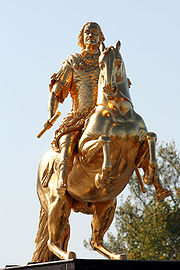
Jean-Joseph Vinache
Encyclopedia

Equestrian sculpture
An equestrian statue is a statue of a rider mounted on a horse, from the Latin "eques", meaning "knight", deriving from "equus", meaning "horse". A statue of a riderless horse is strictly an "equine statue"...
, the Goldener Reiter, the "gilded Horseman", is one of the most familiar sights of Dresden, Germany
Dresden
Dresden is the capital city of the Free State of Saxony in Germany. It is situated in a valley on the River Elbe, near the Czech border. The Dresden conurbation is part of the Saxon Triangle metropolitan area....
, though its sculptor is rarely noted.
Vinache was born in Paris, the son of a bronzefounder. His skill brought him to the attention of an agent of the Elector, "Augustus the Strong", who called him to Dresden to complete an unfinished equestrian sculpture that had been left by the late sculptor François Coudray (1678–1727). A model in gilded plaster and a bronze reduction (Dresden, Grünes Gewölbe
Grünes Gewölbe
The Grünes Gewölbe in Dresden is a unique historic museum that contains the largest collection of treasures in Europe. Founded by Augustus the Strong in 1723, it features a rich variety of exhibits from the Baroque to Classicism...
) preserve the design of this scheme: Augustus, now King of Poland is shown in Roman armour, gripping the baton of power, on a rearing horse, stabilized by a massive tail. The bronze-casting was undertaken in 1733, at the cannon foundry of the Augsburg craftsman Ludwig Wiedemann (1690–1754), established at Dresden-Friedrichstadt
Friedrichstadt (Dresden)
Friedrichstadt is a neighborhood in central Dresden, Germany. A factory district in the late 19th and early 20th centuries, it is known as the home of the founders of the artistic association known as Die Brücke.- History :...
.
Construction of the high pedestal designed by architect Zacharias Longuelune was initiated with a foundation stone, 12 August 1735, but construction was delayed. The completed sculpture was unveiled 26 November 1736.
Retired for safety during World War II
World War II
World War II, or the Second World War , was a global conflict lasting from 1939 to 1945, involving most of the world's nations—including all of the great powers—eventually forming two opposing military alliances: the Allies and the Axis...
, the sculpture survived the Dresden Firestorm
Bombing of Dresden in World War II
The Bombing of Dresden was a military bombing by the British Royal Air Force and the United States Army Air Force and as part of the Allied forces between 13 February and 15 February 1945 in the Second World War...
unscathed and was restored and re-erected on a new plinth in 1956.
Vinache executed numerous other works for Augustus and also made copies after the Antique. A bronze Apollo Leaning on his Lyre (Dresden Skulpturensammlung) was repeated in marble; a reduced terracotta version is at the Musée du Louvre.
In 1736 he returned to Paris, where he was accepted that year at the Académie royale de Peinture et de Sculpture, presenting as his morceau de reception Hercules Enchained by Love; the final marble, delivered 27 May 1741, is at the Musée du Louvre. A marble replica, attributed to Vinache, was sold from the Lagerfeld collection at Christie's Monaco: Friday, April 28, 2000, lot 16.
As an Académicien, Vinache received various public commissions, for an Aurora for Versailles (1746–49) and in Paris. For the chapel of St. Francis Xavier in the Church of St-Paul-St-Louis in the Marais district of Paris, he was commissioned to provide a sculpture illustrating religious zeal, a pendant to the sculpture of Nicolas-Sébastien Adam, called "Adam le jeune", Religion Instructing an Indian; the result was Le Zèle, an angel whipping a fallen heathen among the debris of idolatry, holding open a large folio representing the Gospel. The sculpture was completed in 1745.
A marble Enfants jouant avec des fleurs by Vinache and Nicolas-François Gillet is also conserved at the Louvre.
He died in 1754.

